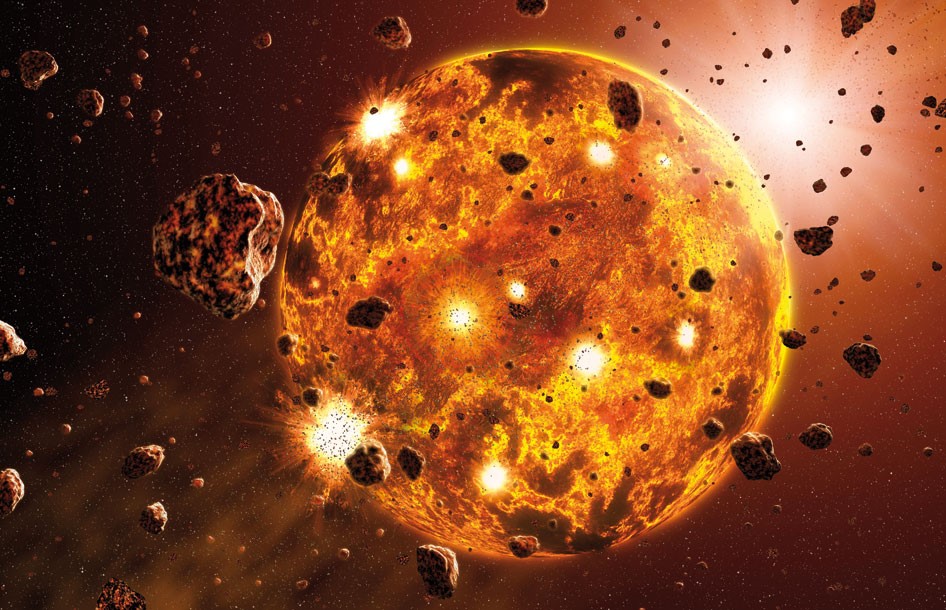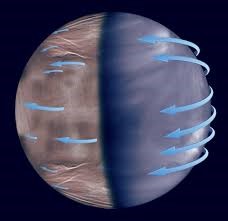The timeline presented below is based on the majority assumptions but which are, for the most part, unconfirmed.
The story of Venus begins several billion years ago, when what will become a planet, will have accumulated the majority of the rocks present in its trajectory, it is the accretion phase. At this stage, the entire surface is covered with lava, due to the multitude of meteorite impacts. It is surrounded by an atmosphere of nitrogen three times more massive than the current Earth’s atmosphere. Once cooled, and after accumulating water from comets, Venus must have looked like what the Earth is today. The atmosphere of nitrogen and carbon dioxide would generate pressure from several bars and oceans small and shallow meeting the conditions necessary for the emergence of a carbon-based life as we know it.

We don’t know exactly why and when, but an increase in temperature ended this period. Once the surface temperature was high enough to vaporize the water, the oceans began to disappear and lose the role of CO2 captor. CO2 and water vapour are powerful greenhouse gases that allow visible sunlight to pass through, warm the planet’s surface but prevent infrared rays emanating from the planet from returning to space. With a reduced ability to evacuate heat, the planet has warmed up, further reducing the amount of water in the oceans. This further exacerbates the warming, until all the liquid water has evaporated.
Under these conditions, the temperature could have reached even higher levels than today. But by going up into the upper layers of the atmosphere, the water vapour is struck by the ultraviolet solar radiation that dissociates it into hydrogen and oxygen. The particularly light hydrogen rises to the limits of the atmosphere where it is “blown” by the solar wind and lost in space. Oxygen, on the other hand, eventually spreads into the atmosphere and some reacts with carbon on the surface to form CO2. The latter greatly increases the mass of the atmosphere, which reaches 100 times the mass of the Earth’s atmosphere. Another part reacts with sulphur of volcanic origin to form sulphur oxides. It in turn combines with the rest of water vapour to create sulphuric acid droplets. This sulphuric acid decomposes because of the temperature below 30km, and is too heavy to rise above 70km. It then concentrates in this area and forms the “cloud zone.” These extremely reflective clouds refer to space 3/4 of the solar energy received by the planet and help to limit the rise in temperatures that still reaches nearly 500°C on the surface.
This massive atmosphere began to behave independently of the surface with a different rotational speed. This rotation could be due to a gravitational tidal effect of the sun or the extension due to the warming of the illuminated face. The atmosphere eventually had an impact on the planet’s rotational speed, due to its gravitational influence or pressure on the reliefs. Over time, the planet slowed down, then canceled its rotation, before starting to turn in the other direction.

On the surface, the disappearance of liquid water has eliminated the “lubricant” effect that allows the functioning of the tectonics of the earth’s plates. The creation/destruction cycle of ocean plates allows the Earth to evacuate heat at the ocean ridge. Otherwise, the heat accumulated under the crust. When this energy became too important, it came to the surface in the form of eruptive episodes that first shattered the highest ground and then covered the lowest plains with lava. After an active phase of a few hundred million years, the planet has calmed down and geological activity has been summed up in a few hot spots. These rise to the surface creating coronas at the center of which volcanoes provide sulphur to the atmosphere. This activity is not enough to drain all the energy generated by the liquid heart of the planet. The heat began to accumulate again for several hundred million to a billion years until the next eruptive episode. The last one occurred 500 million years ago and produced the current relief consisting of a few “continents” emerging far above lava fields.